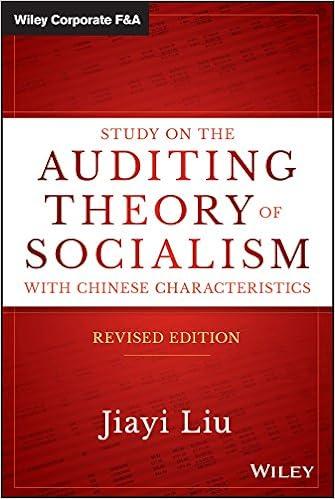Question
1. Generally, capital assets are assets held for investment or personal purposes. Group of answer choices True False 2. Capital losses must be seperated into
1. Generally, capital assets are assets held for investment or personal purposes.
Group of answer choices
True
False
2. Capital losses must be seperated into Short Term and Long Term categories.
Group of answer choices
True
False
3.Gains from the sale of long term capital assets are subject to a higher tax rate that the gains on Short Term capital assets.
Group of answer choices
True
False
4. Gains from the sale of short term assets are not taxed at a preferential rate.
Group of answer choices
True
False
5. Which of the following is a capital asset?
Group of answer choices
A) Inventory held by a manufacturer
B) Accounts receivable held by a dentist
C) All property owned by a taxpayer other than property specifically noted in the law as an exception
D) Depreciable property and real estate used in a trade or business
6. Which of the following is a capital asset?
Group of answer choices
A) A literary work held by the author
B) Real estate held by a developer
C) A taxpayer's personal automobile
D) A truck used in a taxpayer's business
E) None of the above
7. Which of the following is not true about capital assets?
Group of answer choices
A) Real property used in a trade or business is not a capital asset.
B) Capital losses may be carried back for 3 years to offset capital gains in those years.
C) For 2009, net long-term capital gains are granted preferential tax treatment.
D) Individual taxpayers may deduct net capital losses of up to $3,000 per year.
E) Shares of stock held for investment are capital assets.
8. An artist's painting is not a capital asset when held by the artist.
Group of answer choices
True
False
9. Martha has a net capital loss of $20,000 and other ordinary taxable income of $45,000 for the current tax year. What is the amount of Martha's taxable income after deducting the allowed capital loss?
Group of answer choices
A) $25,000
B) $35,000
C) $42,000
D) $45,000
E) None of the above
10. Martha has a net capital loss of $20,000 and other ordinary taxable income of $45,000 for the current year. What is the amount of Martha's capital loss carryforward?
Group of answer choices
A) $0
B) $10,000
C) $14,000
D) $17,000
E) None of the above
11. For the year 20XX, Susan had salary income of $19,000. In addition she reported the following capital transactions during the year:
| Long-term capital gain | $7,000 |
| Short-term capital gain | 3,000 |
| Long-term capital loss | -2,000 |
| Short-term capital loss | -4,000 |
There were no other items includable in her gross income. What is the amount of her adjusted gross income for 20XX?
Group of answer choices
A) $19,000
B) $21,400
C) $23,000
D) $26,000
E) None of the above
Step by Step Solution
There are 3 Steps involved in it
Step: 1

Get Instant Access to Expert-Tailored Solutions
See step-by-step solutions with expert insights and AI powered tools for academic success
Step: 2

Step: 3

Ace Your Homework with AI
Get the answers you need in no time with our AI-driven, step-by-step assistance
Get Started


